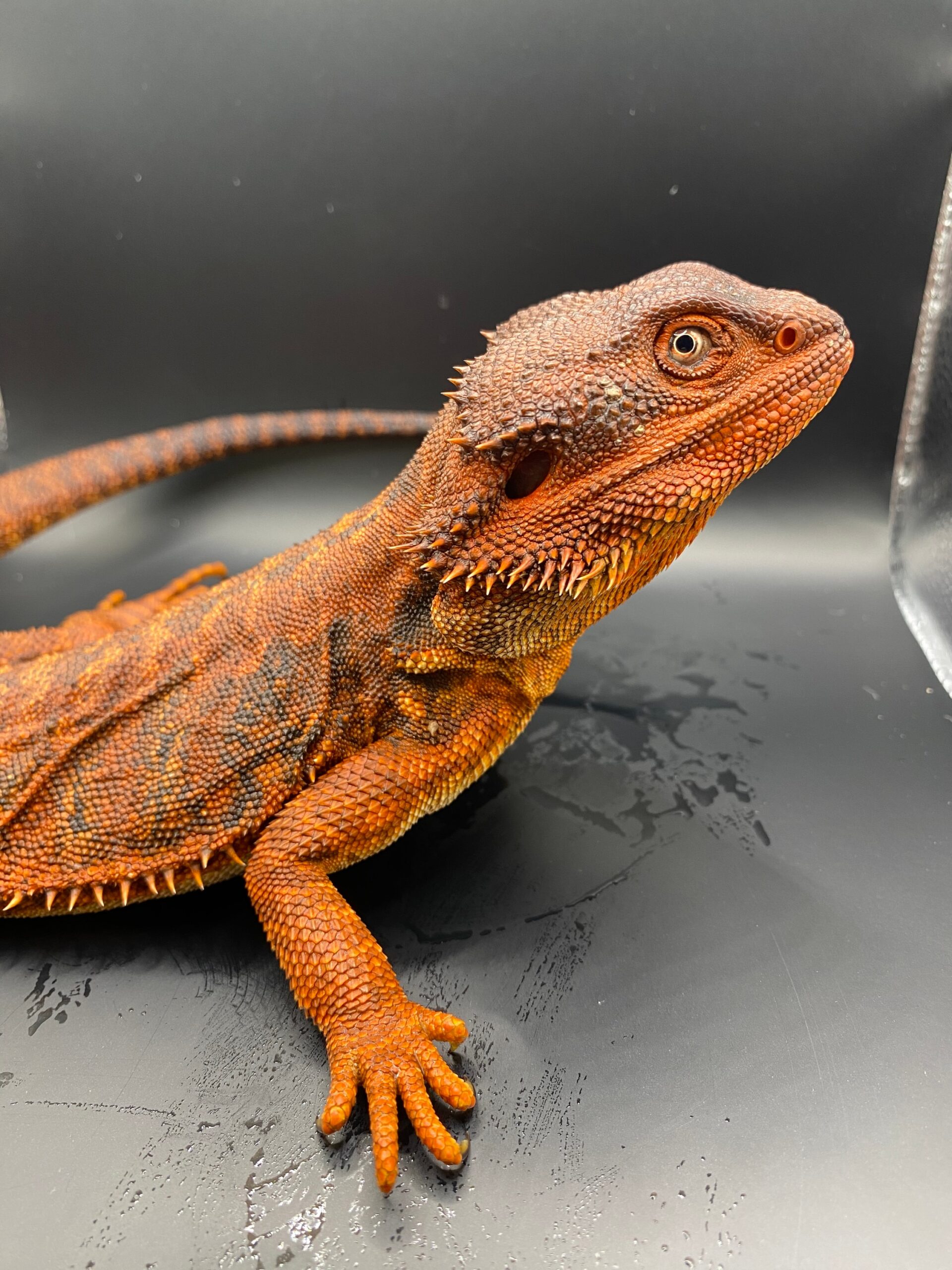BEARDED DRAGON – PURE RED MONSTER TRANSLUCENT (Pogona vitticeps X Pogona barbata)
Full Description
Here is a complete care guide tailored specifically for the Bearded Dragon – Pure Red Monster Translucent morph. While their basic husbandry aligns with standard Pogona vitticeps care, there are some special considerations for their vibrant coloration and translucent trait.
BEARDED DRAGON – PURE RED MONSTER TRANSLUCENT CARE GUIDE
Quick Morph Info:
-
Species: Pogona vitticeps
-
Morph: Pure Red Monster = deep red color line
-
Translucent Trait: Reduced scale opacity, often dark eyes, bluish bellies in young
-
Adult Size: 18–24 inches
-
Lifespan: 10–15 years with proper care
-
Temperament: Friendly, inquisitive, handleable
Enclosure Requirements
Enclosure Size:
-
Juvenile: 40 gal (36″x18″x18″)
-
Adult: 4’x2’x2′ (120 gal or larger) — essential for full-size morphs
-
Glass, PVC, or front-opening terrariums work best
️ Heating & Lighting
Daytime Temps:
-
Basking spot: 100–110°F (38–43°C)
-
Cool side: 75–85°F (24–29°C)
Nighttime Temps:
-
Can safely drop to 65–75°F (18–24°C)
UVB Lighting (Essential):
-
High Output T5 HO UVB tube
-
Zoo Med ReptiSun 10.0 OR Arcadia 12%
-
Mount 10–18″ from basking spot, inside tank with no mesh obstruction
-
-
Replace every 6–12 months depending on brand
Notes for Translucents:
-
Translucent dragons are more light-sensitive, especially in the eyes
-
Avoid overly intense UVB or direct LEDs aimed at the face
-
Monitor for eye closing or light avoidance
Light Cycle
-
12–14 hours light/day using a timer
-
Use white daytime basking bulbs only — no colored night lights
Substrate
Recommended:
-
Tile, slate, or non-adhesive shelf liner
-
Washed play sand or bioactive (for adults only and with experience)
Avoid:
-
Loose substrate for juveniles
-
Calci-sand or crushed walnut — impaction risk
Decor & Enrichment
-
Basking rock or log (beneath heat and UVB)
-
Multiple hides (warm and cool side)
-
Hammock or driftwood for climbing
-
Safe fake or live plants (no pesticides)
Humidity & Water
-
Ideal humidity: 30–40%
-
Daily misting optional — not required
-
Provide a shallow water bowl, refreshed daily
-
Offer a lukewarm soak 1–2x/week to support hydration and shedding
Diet & Feeding
Omnivorous — balance shifts with age
Protein (Insects):
-
Staples: Dubia roaches, black soldier fly larvae, crickets
-
Treats: Hornworms, silkworms, waxworms (infrequent)
Vegetables:
-
Mustard greens, collards, turnip greens, dandelion greens, squash
Fruit (occasional):
-
Berries, mango, papaya, apple (no seeds)
Feeding Schedule:
| Age | Protein | Veggies |
|---|---|---|
| 0–6 months | 2–3x/day (70–80%) | Daily (20–30%) |
| 6–12 months | 1x/day (50/50) | Daily |
| 12+ months | 3–5x/week (30–40%) | Daily (60–70%) |
Supplements
-
Calcium + D3: 4–5x/week for babies, 2–3x/week for adults
-
Multivitamin: 1–2x/week
-
Dust insects lightly — do not overcoat
Health Watch
Common Issues:
-
Metabolic Bone Disease: Prevent with UVB + calcium
-
Dehydration: Lethargy, wrinkled skin — provide soaks
-
Impaction: Avoid large insects & unsafe substrates
-
Shedding Problems: More common in morphs — use moist hide or soak
-
Light Sensitivity: Watch for squinting, especially in Translucents
Handling & Temperament
-
Red Monster Translucents are typically docile and highly handleable
-
Support entire body during handling
-
Limit sessions to ~10–15 minutes until fully acclimated
-
Never grab by the tail
✅ Supplies Checklist
-
120+ gallon enclosure
-
Basking bulb + dome fixture
-
T5 HO UVB linear tube + fixture
-
Digital thermometer + temp gun
-
Hygrometer
-
Basking spot (rock/log)
-
Multiple hides
-
Substrate (tile or safe loose for adults)
-
Feeding tongs, dishes
-
Calcium + D3 and multivitamin powders
-
Insects and fresh greens
-
Water bowl + optional soaking tub
Summary Table
| Care Element | Requirement |
|---|---|
| Basking Temp | 100–110°F (38–43°C) |
| Cool Side Temp | 75–85°F (24–29°C) |
| UVB | T5 HO UVB (10.0 or 12%) |
| Humidity | 30–40% |
| Diet (Adult) | 30–40% insects, 60–70% veggies |
| Morph Consideration | Eye sensitivity (Translucent), color care (Red) |
| Enclosure Size | 4’x2’x2’ minimum (120 gal) |

